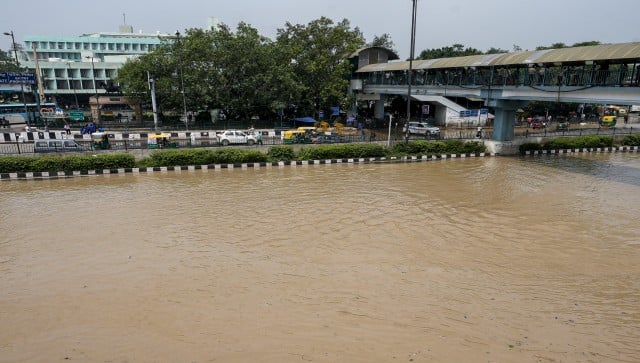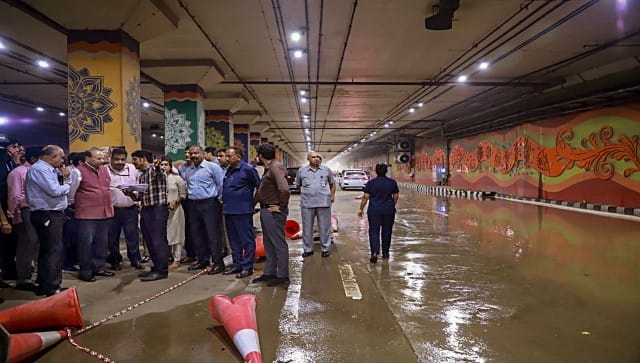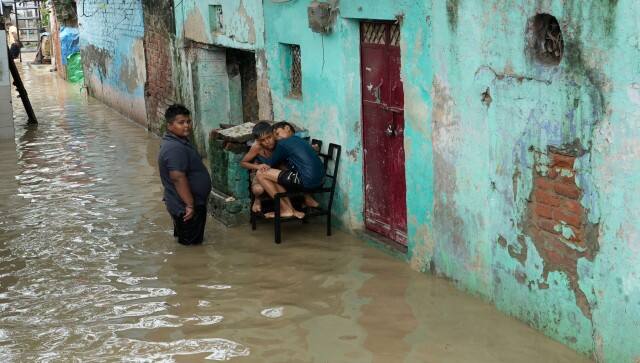Yamuna River water levels are at an all-time high of 208.6 metres, placing Delhi on high flood alert. The National Capital has been seriously affected by the flood, which has significantly disrupted daily life and traffic flow. The 20 million-people city experienced severe rain over the weekend, and flooding in low-lying areas led hundreds of residents to seek shelter in rescue camps. This flood crisis has even prompted an emergency response from government officials. Let’s take a look at how it has brought Delhi to stand still. Also read: Delhi is flooding as Yamuna rises but is the worst yet to come? Schools, colleges, and non-essential government offices shut According to Hindustan Times, the government has decided to extend the shutdown of non-essential government offices, schools, and colleges till Sunday, 16 July, as a result of the Yamuna swelling. Delhi chief minister Arvind Kejriwal shared the news on Twitter.
It has also strongly advised that private businesses implement work-from-home practices during this time. Additionally, businesses near Kashmere Gate have been instructed to suspend operations till Sunday. Drinking water shortage According to Reuters, supplies of drinking water in New Delhi will fall by a quarter on Thursday and Friday because three treatment plants have been flooded, the government said, as the Yamuna River overflowed after incessant rain. “There will be a water problem in some areas of Delhi,” CM Kejriwal said on Twitter, adding, “As soon as the Yamuna water recedes, we will try to start them (the three water treatment plants) as soon as possible.”
Kejriwal said the water level in the river could peak later on Thursday and in the meantime, people were being evacuated from flooded areas. Also read: Yamuna water level at all-time high: How will Delhi-NCR be affected?
Waterlogging, traffic jams On Thursday, the floodwaters inundated a number of significant locations in the National Capital, including the Secretariat, which houses the office of the chief minister. The upscale Civil Lines neighbourhood of the nation’s capital was underwater when river water seeped into the neighbourhood. CM Kejriwal and the Delhi Assembly are only 350 metres away from the river, reported NDTV. [caption id=“attachment_12863812” align=“alignnone” width=“640”] Roads flooded by the swollen Yamuna River, near ISBT in New Delhi. PTI[/caption] Numerous highways, including portions of the major Outer Ring Road, have experienced traffic disruption due to waterlogging. There are severe traffic delays as a result of the vehicles being redirected to alternative routes. The traffic police have also issued advice regarding limits and guidelines for driving owing to flooding.
Roads flooded by the swollen Yamuna River, near ISBT in New Delhi. PTI[/caption] Numerous highways, including portions of the major Outer Ring Road, have experienced traffic disruption due to waterlogging. There are severe traffic delays as a result of the vehicles being redirected to alternative routes. The traffic police have also issued advice regarding limits and guidelines for driving owing to flooding.
India Today reported Monastery Market, Yamuna Bazar, Garhi Mandu, Geeta Ghat, Vishwakarma Colony, Khadda Colony, the vicinity of the Neeli Chatri temple near the Old Railway Bridge, Neem Karoli Gaushala, and a section of the Ring Road from Wazirabad to Majnu Ka Tila are also affected by flooding. Flooding has also forced the closure of the Geeta Colony crematorium in Old Delhi, which is adjacent to the Yamuna River. The Karkarduma and Ghazipur cremation grounds both have facilities for cremations, according to the Municipal Corporation of Delhi (MCD). Delhi metro and bus services affected Delhi Metro services have been impacted by the flood-like situation in the city after the route to Yamuna Bank metro station was closed due to an increase in Yamuna’s water level. The Yamuna Bank station is unavailable, the Delhi Metro Rail Corporation (DMRC) tweeted. This Blue Line station serves as a hub for transfers between Noida and Ghaziabad. The transfer facility is unaffected, according to clarification from the Metro administration. [caption id=“attachment_12863902” align=“alignnone” width=“640”] Delhi Lt Governor VK Saxena during the inspection of waterlogging inside Pragati Maidan tunnel after the recent heavy monsoon rains, in New Delhi. PTI[/caption] DMRC said on Twitter, “Due to the escalating water levels of the Yamuna River, the approach road leading to Yamuna Bank Metro Station is currently inaccessible. Kindly plan your journey accordingly and consider alternate routes. However, interchange facility is available.”
Delhi Lt Governor VK Saxena during the inspection of waterlogging inside Pragati Maidan tunnel after the recent heavy monsoon rains, in New Delhi. PTI[/caption] DMRC said on Twitter, “Due to the escalating water levels of the Yamuna River, the approach road leading to Yamuna Bank Metro Station is currently inaccessible. Kindly plan your journey accordingly and consider alternate routes. However, interchange facility is available.”
Impact Shorts
More ShortsAlthough services are normal, according to DMRC, trains are traversing all Metro bridges at a limited speed. “Due to rising water levels of the Yamuna, trains are passing through all four Metro bridges on the river with a restricted speed of 30 kmph as a precautionary measure. Normal services on all corridors,” it said.
Buses headed for the Inter-State Bus Terminal (ISBT) will temporarily be rerouted to the Singhu Border. Additional buses will be run by the Delhi Transport Corporation (DTC) to take passengers to their destinations, according to India Today. More than 300 mail and express trains and 406 passenger trains have been cancelled between 7 and 15 July due to waterlogging on tracks following heavy rainfall over the past few days, officials said on Thursday. The efforts to lower the water levels are ongoing, according to CM Kejriwal, and restoration work will start in two days. The entry of heavy goods vehicles into the city from four borders, including the Singhu border, has been prohibited by the Delhi administration, with the exception of those transporting necessities. According to today’s statement from Transport Minister Kailash Gahlot, this has been done as a precaution because of the rising Yamuna levels.
Gahlot added in Hindi, “On the other hand, interstate buses coming from Haryana, Himachal Pradesh, Chandigarh, Jammu and Kashmir, Uttarakhand will stop at Singhu border instead of going to ISBT Kashmere Gate.” Vehicles transporting necessities like food and petrol are not restricted, he continued. Also read: Raging Yamuna crosses 45-year record in Delhi, section 144 imposed
Evacuations from risky areas Following an emergency meeting yesterday, CM Kejriwal announced that the government is evacuating regions that are underwater and asked public’s assistance. The National Disaster Response Force has up to 12 teams working as rescuers right now, according to another NDTV report. In order to prevent the entry of floodwater in case Yamuna’s water level rises further, around 16,500 residents in low-lying districts have already been relocated to safer locations at higher altitudes. Additionally, embankments are being built in low-lying areas. Gatherings of four or more individuals and public group movements in flood-prone regions have been outlawed by city police in order to preserve order. [caption id=“attachment_12863932” align=“alignnone” width=“640”] Locals wade through a flooded bylane at Yamuna Bazar area, in New Delhi. PTI[/caption] As the situation worsens, Kejriwal has written to Union home minister Amit Shah, urging to release a limited quantity of water from the Hathni Kund Barrage in Haryana. Following receiving his letter, he claimed to have heard back from Union Minister Gajendra Shekhawat, who claimed that a decrease in the amount of water being discharged to Haryana from Himachal Pradesh would have an impact on the Yamuna river level. Hindustan Times quoted Kejriwal as saying, “Following my letter, I got a call from Union minister Gajendra Singh Shekhawat, who said that Hathnikund is just a barrage and there is no reservoir to store water and limit the water speed. The water volume being released from Himachal Pradesh has reduced and the situation will improve. But it will take time to reflect in the water level of the Yamuna.” Lieutenant Governor VK Saxena and Kejriwal-led Delhi Disaster Management Authority (DDMA) would continue to meet to go over and manage the flood situation in the city. The causes of flooding On the Yamuna River, there are two significant fortifications: Dakpathar in Uttarakhand and Hathnikund in Haryana, upstream of Delhi. Since there are no dams on the river, the majority of the monsoon flow is wasted and floods occur throughout the rainy season. Saturated soil due to heavy downpours in Delhi and the surrounding areas over the weekend and ongoing rains in the upper catchment areas have both contributed to the rise in water levels, according to India Today. The Central Water Commission (CWC) tweeted that the Hathni Kund Barrage has limited storage as a reason for the rise in Yamuna level. He said, “Hathni Kund Barrage has limited storage. During high inflows, excess water is to be released downstream. Very heavy rainfall occurred in the Himalayan region upstream of Hathni Kund Barrage during 9-11 July.” The water flow from the Haryana barrage is anticipated to begin decreasing at around 2:00 PM today, but the India Meteorological Department (IMD) has forecast that Uttarakhand will continue to experience heavy to extremely heavy rains over the following two days, increasing the risk of floods. According to IMD, Delhi has had record rainfall since the monsoon season started on 1 June. Punjab and Himachal Pradesh have experienced 100 per cent and 70 per cent more rain than typical, respectively. The weather agency says that rainfall in Delhi has also been 112 per cent above average. With inputs from PTI and Reuters
Locals wade through a flooded bylane at Yamuna Bazar area, in New Delhi. PTI[/caption] As the situation worsens, Kejriwal has written to Union home minister Amit Shah, urging to release a limited quantity of water from the Hathni Kund Barrage in Haryana. Following receiving his letter, he claimed to have heard back from Union Minister Gajendra Shekhawat, who claimed that a decrease in the amount of water being discharged to Haryana from Himachal Pradesh would have an impact on the Yamuna river level. Hindustan Times quoted Kejriwal as saying, “Following my letter, I got a call from Union minister Gajendra Singh Shekhawat, who said that Hathnikund is just a barrage and there is no reservoir to store water and limit the water speed. The water volume being released from Himachal Pradesh has reduced and the situation will improve. But it will take time to reflect in the water level of the Yamuna.” Lieutenant Governor VK Saxena and Kejriwal-led Delhi Disaster Management Authority (DDMA) would continue to meet to go over and manage the flood situation in the city. The causes of flooding On the Yamuna River, there are two significant fortifications: Dakpathar in Uttarakhand and Hathnikund in Haryana, upstream of Delhi. Since there are no dams on the river, the majority of the monsoon flow is wasted and floods occur throughout the rainy season. Saturated soil due to heavy downpours in Delhi and the surrounding areas over the weekend and ongoing rains in the upper catchment areas have both contributed to the rise in water levels, according to India Today. The Central Water Commission (CWC) tweeted that the Hathni Kund Barrage has limited storage as a reason for the rise in Yamuna level. He said, “Hathni Kund Barrage has limited storage. During high inflows, excess water is to be released downstream. Very heavy rainfall occurred in the Himalayan region upstream of Hathni Kund Barrage during 9-11 July.” The water flow from the Haryana barrage is anticipated to begin decreasing at around 2:00 PM today, but the India Meteorological Department (IMD) has forecast that Uttarakhand will continue to experience heavy to extremely heavy rains over the following two days, increasing the risk of floods. According to IMD, Delhi has had record rainfall since the monsoon season started on 1 June. Punjab and Himachal Pradesh have experienced 100 per cent and 70 per cent more rain than typical, respectively. The weather agency says that rainfall in Delhi has also been 112 per cent above average. With inputs from PTI and Reuters
)